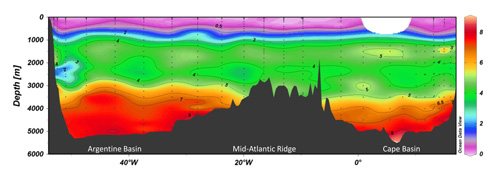What does the largest data set of zinc concentration ever reported tell us?
Zinc (Zn) is one of the key micronutrients that are measured during the GEOTRACES cruises. N.J. Wyatt and colleagues (2014; see reference below) largely contributed to this collective effort by measuring Zn distribution at high resolution (556 discrete samples) between Cape Town and Montevideo in the South Atlantic Ocean (40°S) on board the UK GEOTRACES GA10 cruise.
The reported surface Zn concentrations are among the lowest reported for the world’s oceans (0.015 – 0.39 nM). An intriguing result was the fact that Zn concentrations were very low down to depths of 500m, which was similar to that of silicate (Si) concentrations. Using the strong relationship between Zn and Si, the authors present a new tracer Zn* (Zn* = Zn – 0.065 x Si + 0.209), which illustrates that Zn is removed from surface waters in the Southern Ocean and remineralised deeper in the water column. This results in very low Zn concentrations in Sub-Antarctic-Mode Water (SAMW), which is the main pathway for supplying nitrate and phosphate to the thermocline waters of the South and North Atlantic. These low Zn concentrations in SAMW may result in growth-limiting Zn concentrations in the surface waters of both the South and North Atlantic sub-tropical gyres.

Figure: Concentrations of Zn along GA10 section (~40°S). Warm colours indicate high concentrations.
Click here to view the figure larger or here to view a map of GEOTRACES Sections in the Atlantic.
Reference:
Wyatt, N. J., Milne, A., Woodward, E. M. S., Rees, A. P., Browning, T. J., Bouman, H. A., Worsfold, P. J., Lohan, M. C. (2014). Biogeochemical cycling of dissolved zinc along the GEOTRACES South Atlantic transect GA10 at 40°S. Global Biogeochemical Cycles, 28(1), 44–56. doi:10.1002/2013GB004637. Click here to view the paper.
